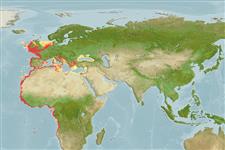>
Pleuronectiformes (Flatfishes) >
Soleidae (Soles)
Etymology: Pegusa: The old name of the Cnidus, the city in Asia minos where the Atheniasn defeated Spartans in a naval battle near 394 BC.
More on author: Risso.
Environment: milieu / climate zone / intervalo de profundidade / distribution range
Ecologia
marinhas; estuarina demersal; intervalo de profundidade 5 - 350 m (Ref. 4710), usually 20 - 50 m (Ref. 26999). Subtropical; 57°N - 17°S, 18°W - 42°E
Eastern Atlantic: northeastern to southeastern Atlantic; perhaps Gulf of Guinea; the Mediterranean Sea and Black Sea; reported from Suez Canal (Ref. 32649); and Sea of Azov (Ref. 4710).
Length at first maturity / Tamanho / Peso / Idade
Maturidade: Lm ?, range 22 - ? cm
Max length : 40.0 cm SL macho/indeterminado; (Ref. 4710); common length : 30.0 cm TL macho/indeterminado; (Ref. 2714); Idade máx. registada: 15 anos (Ref. 32766)
Espinhos dorsais (total) : 0; Raios dorsais moles (total) : 69 - 87; Espinhos anais: 0; Raios anais moles: 53 - 73; Vértebras: 40 - 48. Last ray of dorsal and anal fins joined by a low membrane to the base of the caudal fin. Supratemporal branch of lateral line forming an arch. Anterior nostril on the blind side prominent forming a large round rosette, its diameter equal to that of the eye. Lower lip on ocular side undulated with about 6 lobes. Length of both nasal tubes and scales above it on the ocular side about equal. Pectoral fin on the ocular side with a black botch with a white margin except at its base; this blotch often interrupted by light space or accompanied by dots or streaks on one side or the other (present in fresh specimens from coast of Israel (Ref. 32649). Brownish yellow or reddish brown in color with obscure pale blotches and specks (Ref. 3200).
Body shape (shape guide): short and / or deep.
Found on gravel, sand or mud. Feeds on a wide range of small marine bivalves; mainly on crustaceans such as amphipods, mysids, shrimps, decapods, bivalves and polychaetes (Ref. 4710).
Ben-Tuvia, A., 1990. A taxonomic reappraisal of the Atlanto-Mediterranean soles Solea solea, S. senegalensis and S. lascaris. J. Fish Biol. 36(6):947-960. (Ref. 32649)
Categoria na Lista Vermelha da IUCN (Ref. 130435: Version 2024-2)
Ameaça para o homem
Harmless
Utilização humana
Pescarias: pouco comercial
Ferramentas
Relatórios especiais
Descarregue XML
Fontes da internet
Estimates based on models
Preferred temperature (Ref.
123201): 10.6 - 27.6, mean 18.1 °C (based on 512 cells).
Phylogenetic diversity index (Ref.
82804): PD
50 = 0.5312 [Uniqueness, from 0.5 = low to 2.0 = high].
Bayesian length-weight: a=0.00891 (0.00758 - 0.01048), b=3.06 (3.01 - 3.11), in cm total length, based on LWR estimates for this species (Ref.
93245).
Nível Trófico (Ref.
69278): 3.3 ±0.1 se; based on diet studies.
Resiliência (Ref.
120179): Médio, tempo mínimo de duplicação da população 1,4 - 4,4 anos (K=0.41; tm=4; tmax=15).
Fishing Vulnerability (Ref.
59153): Low to moderate vulnerability (29 of 100).
🛈
Climate Vulnerability (Ref.
125649): Low vulnerability (18 of 100).
🛈
Nutrients (Ref.
124155): Calcium = 133 [47, 301] mg/100g; Iron = 1.03 [0.42, 2.11] mg/100g; Protein = 18.5 [16.7, 20.5] %; Omega3 = 0.175 [0.082, 0.365] g/100g; Selenium = 38.4 [18.7, 82.5] μg/100g; VitaminA = 9.21 [3.14, 27.04] μg/100g; Zinc = 0.885 [0.576, 1.305] mg/100g (wet weight); based on
nutrient studies.
